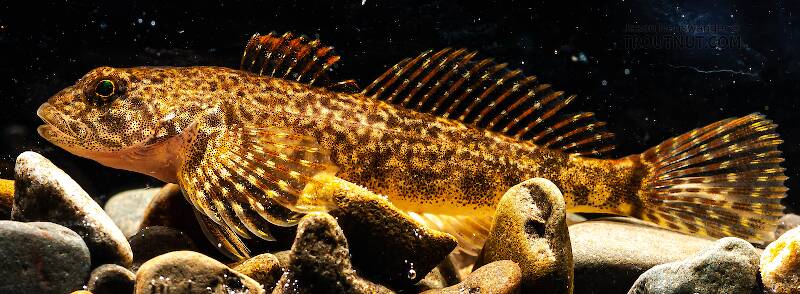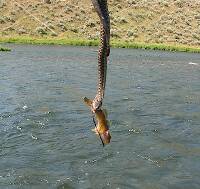
Salmonflies
Pteronarcys californica
The giant Salmonflies of the Western mountains are legendary for their proclivity to elicit consistent dry-fly action and ferocious strikes.
Featured on the forum

This specimen keys to the Epeorus albertae group of species. Of the five species in that group, the two known in Washington state are Epeorus albertae and Epeorus dulciana. Of the two, albertae has been collected in vastly more locations in Washington than dulciana, suggesting it is far more common. On that basis alone I'm tentatively putting this nymph in albertae, with the large caveat that there's no real information to rule out dulciana.

Troutnut is a project started in 2003 by salmonid ecologist Jason "Troutnut" Neuswanger to help anglers and
fly tyers unabashedly embrace the entomological side of the sport. Learn more about Troutnut or
support the project for an enhanced experience here.

This seems to be a mottled sculpin, Cottus bairdi. Normally this species is more mottled.
Taxon on May 18, 2007May 18th, 2007, 4:49 pm EDT
Jason-
I believe it to be a Mottled Sculpin (Cottus bairdii), which occurs in rubble and gravel riffles, and is less often in sand-gravel runs of headwaters, creeks and small rivers. Also found in springs and their effluents and rocky shores of lakes, they feed mainly on aquatic insect larvae, but also on crustaceans, annelids, fishes, fish eggs, and plant material.

I believe it to be a Mottled Sculpin (Cottus bairdii), which occurs in rubble and gravel riffles, and is less often in sand-gravel runs of headwaters, creeks and small rivers. Also found in springs and their effluents and rocky shores of lakes, they feed mainly on aquatic insect larvae, but also on crustaceans, annelids, fishes, fish eggs, and plant material.

Troutnut on May 18, 2007May 18th, 2007, 5:26 pm EDT
My dad (a fishery biologist) also says its probably a mottled sculpin.
His IM:
Also, the Fishes of New York website from Cornell lists only the mottled sculpin and slimy sculpin. So as long as everyone's in agreement that it's not the latter, I'll call it a mottled sculpin for now.
His IM:
Your new fish is probably a mottled sculpin, Cottus bairdi. It's fairly light in color for a mottled sculpin, and the typical dark bands don't show well; but this species can change its color in response to stress or environmental conditions more than most fish. All the other dimensions, fin ray counts, etc. suggest its a mottled sculpin.
But given that there are over 20 freshwater species of sculpins in North America.... and I don't know the New York State species.... this could be a close relative of the mottled sculpin.
But it's safe to say that if you captured this fish in Missouri or Wisconsin, you would not hesitate to identify it as a mottled sculpin.
Also, the Fishes of New York website from Cornell lists only the mottled sculpin and slimy sculpin. So as long as everyone's in agreement that it's not the latter, I'll call it a mottled sculpin for now.
Jason Neuswanger, Ph.D.
Troutnut and salmonid ecologist
Troutnut and salmonid ecologist
Taxon on May 18, 2007May 18th, 2007, 6:01 pm EDT
David-
Actually, it wasn't all that quick. The fact is, just six weeks ago, I had prepared a report on WA resident freshwater sculpin for a fellow fly tyer in a flyfishing club to which I belong. Having already done this research allowed me to simply compare Jason's specimen photos to those I had collected previously, and a visual match jumped out at me.
Incidentally, freshwater sculpin (genus Cottus), are represented in North America by (57) species, and in WA by (10) species, but according to NatureServe Explorer, by only (2) species in NY. The other one is Slimy Sculpin (Cottus cognatus), which is likely the one Jason is more accustomed to seeing.
Hope my answer satisfactorily addresses the point of your question. However, if I've somehow missed the mark, just let me know.
Actually, it wasn't all that quick. The fact is, just six weeks ago, I had prepared a report on WA resident freshwater sculpin for a fellow fly tyer in a flyfishing club to which I belong. Having already done this research allowed me to simply compare Jason's specimen photos to those I had collected previously, and a visual match jumped out at me.
Incidentally, freshwater sculpin (genus Cottus), are represented in North America by (57) species, and in WA by (10) species, but according to NatureServe Explorer, by only (2) species in NY. The other one is Slimy Sculpin (Cottus cognatus), which is likely the one Jason is more accustomed to seeing.
Hope my answer satisfactorily addresses the point of your question. However, if I've somehow missed the mark, just let me know.
GONZO on May 19, 2007May 19th, 2007, 5:44 am EDT
David,
Sculpin diversity in the East is not limited to two species, but the mottled sculpin and the slimy sculpin are by far the most common. This does appear to be a mottled sculpin, but they can be pretty difficult to tell apart. (The mottled sculpin will have palatine teeth, and the slimy won't.)
Other (rarer) Eastern species include:
The spoonhead sculpin (Cottus ricei) and deepwater sculpin (Myoxocephalus thompsoni) are deepwater species found in the Great Lakes.
The Potomac sculpin (Cottus girardi) is found in the Potomac drainage, and the Blue Ridge sculpin (Cottus caeruleomentum) is a new species distinguished from the mottled sculpin by protein analyses and some morphological traits.
The black sculpin (Cottus baileyi) is found in headwaters of the Watauga, Clinch, and Holston rivers (VA and TN).
The pygmy sculpin (Cottus pygmaeus) is restricted to Coldwater Spring, Calhoun County, Alabama.
Sculpin diversity in the East is not limited to two species, but the mottled sculpin and the slimy sculpin are by far the most common. This does appear to be a mottled sculpin, but they can be pretty difficult to tell apart. (The mottled sculpin will have palatine teeth, and the slimy won't.)
Other (rarer) Eastern species include:
The spoonhead sculpin (Cottus ricei) and deepwater sculpin (Myoxocephalus thompsoni) are deepwater species found in the Great Lakes.
The Potomac sculpin (Cottus girardi) is found in the Potomac drainage, and the Blue Ridge sculpin (Cottus caeruleomentum) is a new species distinguished from the mottled sculpin by protein analyses and some morphological traits.
The black sculpin (Cottus baileyi) is found in headwaters of the Watauga, Clinch, and Holston rivers (VA and TN).
The pygmy sculpin (Cottus pygmaeus) is restricted to Coldwater Spring, Calhoun County, Alabama.
GONZO on May 19, 2007May 19th, 2007, 8:25 am EDT
I didn't mean to imply that there are only two species in the east....
You didn't imply this, David, and I appreciate the additional insights into sculpin evolution. I was just surprised that the NY references didn't include the deepwater Great Lakes species. Several PA references do include them, even though they are considered extirpated species here. (Some may exist in Lake Erie, but this seems uncertain.)
And I certainly agree that they are "cool little fishes." This is a very beautiful specimen, whatever the species.
GONZO on May 19, 2007May 19th, 2007, 1:52 pm EDT
David,
Just as a side note, and because we share a fascination with sculpins, I thought I'd mention that we also have a few marine species in the East. Of those, the longhorn sculpin, Myoxocephalus octodecimspinosus, (quite a mouthful!) and the shorthorn sculpin, Myoxocephalus scorpius, are the most common.
I'm familiar with the shorthorn because--I'm embarrassed to admit--I once collected a very large specimen with a Hawaiian sling while doing breath-holding dives in the frigid waters off Acadia NP, Maine. I was immediately ashamed of myself, and that episode ended my incomprehensible interest in sling-fishing forever!
Just as a side note, and because we share a fascination with sculpins, I thought I'd mention that we also have a few marine species in the East. Of those, the longhorn sculpin, Myoxocephalus octodecimspinosus, (quite a mouthful!) and the shorthorn sculpin, Myoxocephalus scorpius, are the most common.
I'm familiar with the shorthorn because--I'm embarrassed to admit--I once collected a very large specimen with a Hawaiian sling while doing breath-holding dives in the frigid waters off Acadia NP, Maine. I was immediately ashamed of myself, and that episode ended my incomprehensible interest in sling-fishing forever!
Quick Reply
Related Discussions
Topic
Replies
Last Reply
6
Dec 23, 2007
by Krachen
by Krachen
5
Apr 30, 2011
by Keystoner
by Keystoner
7
May 29, 2012
by Possumpoint
by Possumpoint




